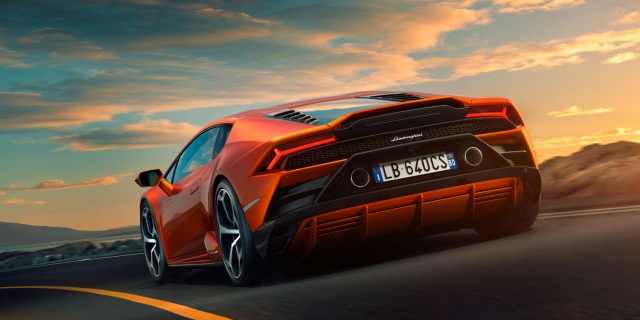What's the news?
Lamborghini has worked upon the (for want of a better word) regular version of its 2014-launched Huracan V10-powered supercar, delivering the Huracan Evo for the 2019MY. It gains the upgraded engine from the exotic Performante model and a vehicle dynamics control system that uses predictive logic, for the first time in any Lambo.
Exterior
Lamborghini has altered the shape of the Huracan Evo's front bumper, incorporating a new splitter with integrated wing for better aerodynamic abilities. Larger air intakes feature the 'Ypsilon' (that's 'Y', to you or us) design detail that you'll see everywhere on the Italian company's modern products. There are new side air intakes and designs of alloy wheel for the Huracan Evo, while at the back it's significantly different, with a couple of high-mounted, twin exhausts framing a rear which includes an integrated, slotted spoiler, a big rear diffuser and enhanced detailing. Lamborghini claims the Evo is 'more than five times' as aerodynamically efficient as the original 2014 Huracan, while also boasting additional downforce, too. Other than that, a new four-layer paint called Arancio Xanto is on the cards, as are 20-inch Aesir rims and the full Lamborghini Ad Personam customisation service.
Interior
The main talking points here are an interior trim that is specific to the Huracan Evo, which features a leather and Alcantara mix and which boasts Arancio Dryope detailing to match the orange exterior body colour. Lightweight materials, such as carbon fibre and Lamborghini's patented Carbon Skin, can be specified, while a new 8.4-inch capacitive touchscreen headlines the human-machine interface of the Evo.
Mechanicals
It's the same 5.2-litre naturally aspirated V10 in the middle of the Huracan Evo, only now - as mentioned at the top of the piece - it's developing the same outputs as the Performante, which means 640hp at 8,000rpm and 600Nm at 6,500rpm. With a weight of 1,422kg, that means the four-wheel-drive Evo can run 0-100km/h in 2.9 seconds, 0-200km/h in 9.0 seconds and go on to a top speed in excess of 325km/h. Strong brakes mean 100km/h to a complete halt can be conducted in 31.9 metres. The Lamborghini Dinamica Veicolo Integrata (LDVI) is the new feature, a central processing unit that controls every aspect of the car's dynamic behaviour. It works with the Evo's new rear-wheel-steering system and four-wheel torque vectoring to ensure the car is always in the optimum set-up for the road ahead. Magnetorheological dampers are overseen by Lamborghini Piattaforma Inerziale (LPI) v2.0, a programme which monitors roll, pitch and yaw during cornering.
Anything else?
Stefano Domenicali, chairman and CEO of Automobili Lamborghini, said: "Lamborghini is intent on leading the advance to the highest level of super sports car technologies and driving emotion. This is the essence of the new Huracan Evo. It takes the extraordinary abilities of the Huracan Performante and combines state-of-the-art vehicle dynamic control to amplify the everyday Huracan driving experience. The Huracan Evo is the very definition of evolution: it is a step ahead, redefining the segment parameters. It is remarkably easy to drive, while delivering the most responsive, sensory and agile driving experience, in every environment."
The Huracan Evo will cost around €226,450 here, excluding the VRT which is set by its as-yet unspecified CO2 outputs.





